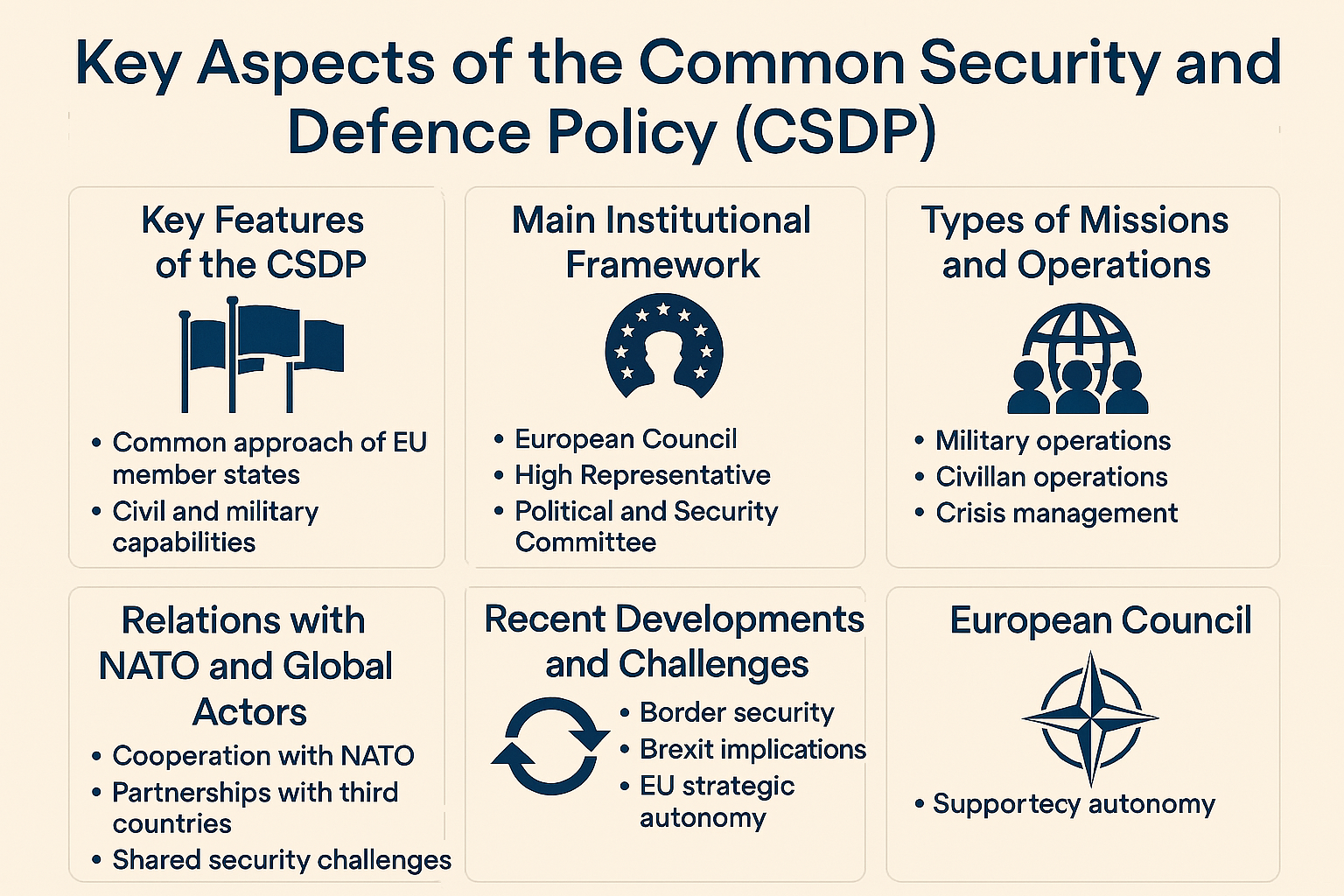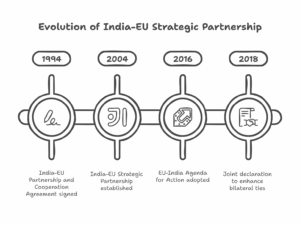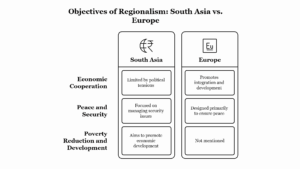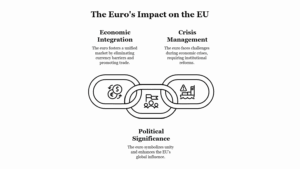The Common Security and Defence Policy (CSDP) is an integral part of the European Union’s (EU) overarching framework for foreign and security policy. It provides the EU with the means to address security challenges both within its borders and in the wider international environment. The CSDP aims to safeguard the EU’s values, interests, and territorial integrity, while promoting international peace and security.
The development of the CSDP is guided by the Treaty of Lisbon (2009), which consolidated and enhanced the EU’s capabilities in the area of security and defense. Prior to this, various aspects of EU foreign and defense policy had evolved through the European Security and Defence Policy (ESDP), which began with the Maastricht Treaty (1992). This shift culminated in a more integrated approach to security and defense under the CSDP, highlighting the EU’s growing role as a global security actor.
1. Key Features of the CSDP
The CSDP is designed to allow the EU to react rapidly to crises, contribute to conflict prevention, and support peacebuilding in regions of strategic importance. Several core principles define the CSDP:
- Common Approach: The CSDP reflects a shared political will among EU member states to act together in defense and security matters. While the EU does not have a common army, member states cooperate on various defense initiatives, including military and civilian missions.
- Civil and Military Capabilities: The EU’s approach to security includes both military and civilian tools. These capabilities are developed and deployed for operations that range from peacekeeping and crisis management to humanitarian assistance and the support of democratic transitions.
- Autonomy in Decision-Making: The EU seeks to maintain autonomous decision-making on defense and security issues, while still cooperating closely with NATO. The EU aims to ensure that it is capable of acting independently in cases where NATO is unable or unwilling to intervene.
2. The Main Institutional Framework for the CSDP
Several key EU institutions are involved in the management and implementation of the CSDP:
- European Council: The European Council (composed of EU heads of state or government) plays a leading role in setting the strategic direction for the CSDP. The Council decides on the guidelines for military and civilian missions and approves their launch.
- High Representative of the Union for Foreign Affairs and Security Policy: This position, held by Josep Borrell (as of 2021), is responsible for coordinating and overseeing the EU’s foreign and security policy. The High Representative also chairs the Foreign Affairs Council and represents the EU in international diplomacy.
- Political and Security Committee (PSC): The PSC is responsible for the political direction of the CSDP. It meets regularly to analyze emerging threats and provide recommendations on how to respond to international crises.
- European External Action Service (EEAS): The EEAS, created by the Treaty of Lisbon, is a diplomatic service that supports the High Representative and works closely with member states to develop and execute EU foreign policy, including CSDP missions.
- European Defence Agency (EDA): The EDA helps member states develop their defense capabilities and fosters military cooperation in areas such as procurement, research, and training.
- EU Military Staff (EUMS): The EUMS provides military expertise for the planning and execution of CSDP operations, ensuring that the EU has the technical capability to respond to security crises.
3. Types of CSDP Missions and Operations
The EU deploys a range of military and civilian operations under the CSDP. These operations are usually deployed in regions facing instability or conflict, such as Africa, the Middle East, and Eastern Europe. They fall into several categories:
- Military Operations: These involve the deployment of EU military forces to address security challenges, protect civilians, or support peace agreements. Examples include EUFOR Althea in Bosnia and Herzegovina, which is tasked with maintaining security post-conflict, and EUTM Mali, a mission focused on training local forces to combat terrorism.
- Civilian Operations: Civilian operations focus on peacebuilding, rule of law, and democratic governance. These missions include EUAM Ukraine, which assists Ukraine in reforming its security sector, and EUPOL Afghanistan, which supported the Afghan police force in rebuilding law and order.
- Crisis Management: The EU is often called upon to provide humanitarian assistance, conflict prevention, and peacekeeping in crisis situations. For example, the EU Civilian Monitoring Mission (EUMM) in Georgia monitors the situation in regions affected by the Russia-Georgia conflict.
4. Relations with NATO and Other Global Actors
The relationship between the EU and NATO is crucial for the success of the CSDP. While the EU aims for autonomy in defense matters, it maintains a strong partnership with NATO, particularly in terms of military capability and strategic coordination. Both organizations face similar security threats, and cooperation between them is essential for maintaining regional stability.
- EU-NATO Cooperation: Both organizations cooperate in areas such as crisis management, intelligence sharing, and counter-terrorism efforts. For instance, NATO and the EU have worked together in addressing the conflict in Afghanistan and in responding to the Libyan crisis.
- Challenges: Despite these efforts, the relationship is often complicated by differences in membership. While NATO includes the United States and other non-EU countries, some EU members are not part of NATO (e.g., Ireland, Austria). Additionally, differences in political priorities can occasionally hinder full collaboration.
The EU also seeks to engage with third countries and international organizations to enhance global security. Partnerships with countries like the United States, Russia, and China are central to addressing issues such as terrorism, cybersecurity, and regional conflicts.
5. Recent Developments and Challenges
The CSDP has faced several challenges in recent years, particularly in light of evolving global security threats such as hybrid warfare, cyberattacks, and terrorism.
- The Refugee Crisis and Border Security: The migration crisis in Europe has highlighted the need for stronger border security and internal cooperation within the EU. The CSDP has expanded to include missions focusing on border control and refugee management, such as EUROPOL and Frontex.
- Brexit: The United Kingdom’s departure from the EU has had significant implications for CSDP. The UK was a major player in EU defense matters, and its exit has raised questions about the future direction of European defense cooperation.
- EU Strategic Autonomy: The EU has increasingly emphasized the need for strategic autonomy, which means the ability to make its own defense decisions without excessive reliance on NATO or the United States. This vision has become more pronounced in response to shifting global power dynamics and the changing role of the US in European security.
6. Conclusion
The Common Security and Defence Policy (CSDP) represents the EU’s commitment to ensuring its security and the stability of its immediate neighbourhood through cooperation, prevention, and response to security challenges. While it is still evolving, the CSDP has enabled the EU to play an important role in global peacekeeping and conflict resolution.
However, challenges such as coordination among member states, resource limitations, and the need for closer cooperation with NATO and other international actors remain significant. As the EU faces new security threats, its ability to adapt and deepen its defense capabilities will be critical in maintaining its position as a key player in global security.








Leave a Reply